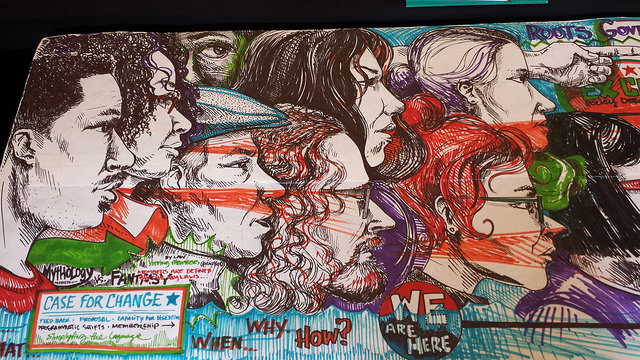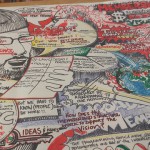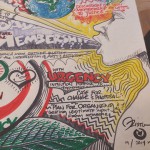Article by Ashley Minner (Baltimore, MD)
For a little over a year now, Alternate ROOTS members and staff have been exploring our membership and governance structures through the guidance of the EmcArts Innovation Lab process. You may remember some of the places where you’ve been involved in the process, including the survey we sent out to the full membership last summer, our report at ROOTS Week 2013 and updates in our newsletter (by the way, Shannon M. Turner originally wrote this in a newsletter update). To date, there have been multiple gatherings of members in different phases of the project. Phase 1, the pilot phase, involved two gatherings in Summer 2013 that included a range of participants from founding members, Kathie deNobriga and Linda Parris-Bailey, to newer members like Imhotep Dlanod and Morgana Wallace-Cooper. As a result of those sessions, we arrived at the following statement of our adaptive challenge:
As the need for our services grows, as our community churns and becomes more diverse, and as the systems of our organization become more nuanced, we need organizational membership and governance structures that are more clear, adaptive, and nimble, honor multiple forms of participation, promote network building, and champion creative expression as a pathway to equity.
That language was submitted with our successful application to EmcArts, which led to Phase II. With Phase II, we convened a core team including: Dudley Cocke (Founding Member, KY), Dan Brawley (Board Chair, NC), myself — Ashley Minner (ExCom Member & Innovation Ensemble Chair, MD), Carrie Brunk (ROOTS ally and organizer, KY), and Ariston Jacks (ROOTS member and visual artist, AR), as well as our full staff: Carlton Turner (Executive Director, MS), Keryl McCord (Managing Director), Ashley Davis (Community Partnerships Specialist), and Shannon M. Turner (Manager of Programs & Services). Our EmcArts facilitator is John Shibley (Maine).
The work of this team culminated in a week-long intensive process this past March in Warrenton, Virginia. We emerged with concrete, structured proposals that were then presented to ExCom at our April face-to-face meeting in Tampa, Florida. They have since been further developed and are to be presented to the full membership at ROOTS Week 2014.
The purpose of this article is to inform ROOTers about the EmcArts Innovation Lab process as well as the changes that are being proposed and one decision that has already been made as a result. ExCom has been busy trying to personally contact the entire voting membership prior to ROOTS Week for this same purpose. You may have already received a phone call. Here is a breakdown of the changes that are being proposed and one decision that has been made as a result of our EmcArts Innovation Lab Process:
I. Membership Structure
We propose to create / revive a category of “General Membership.” This will increase access to membership for more people (yay!) and offer a membership option that does not require a commitment of legal and fiduciary responsibility from everyone who wants to be a part of ROOTS (whew!). In this new arrangement, folks can come forward for Voting Membership, which does include a commitment of legal responsibility, if and when they are interested in being involved at that level. In order to make this change, we have to amend our ROOTS Membership Policy. Per our by-laws, changes to membership structure require a majority vote of the Voting Membership with 10% quorum. If this proposed change is approved by our Voting Membership at ROOTS Week, we will then have 3 categories of formal membership within ROOTS: Voting, General and Organizational. General Membership is open to anyone, anywhere and Voting Membership is open to folks living and working in the U.S. South. Satellite and Introductory Membership will no longer be necessary categories. People can also affiliate as an “Ally” of ROOTS through the Friends Program, though this does not convey membership benefit or responsibilities. Cool.
II. Membership Induction
We propose to change the frequency of member induction to be throughout the year. This will allow people to join ROOTS at any time, rather than only at the Annual Business Meeting, a practice that has restricted reach and accessibility (because not everybody can leave home and work for a week and travel to Arden to be with us, no matter how much fun it is.) In order to make this change, we must amend the ROOTS Membership Policy. Again, per our by-laws, changes to our membership structure require a majority vote of the Voting Membership with 10% quorum. In short, if this proposed change is approved by our Voting Membership at ROOTS Week, General Members will be accepted on a rolling basis by staff and Voting Members will be considered and reviewed by the Membership Ensemble on conference calls open to all Voting Members. And the details of how membership application and induction would happen are outlined in the new proposed Membership Policy that has been drafted by our fabulous Membership Innovation Ensemble (which, by the way, you can join if you feel so inclined at ROOTS Week or by getting in touch with the Chair, Dan Brawley.)
III. Executive Committee
We will elect a strategically chosen ExCom with staggered rotation and multi-year commitments to allow for continuity of experience in balance with opportunities for new leadership. This ensures that our ExCom has the range of skills, experience and diversity necessary to guide and represent ROOTS effectively in partnership with staff. It further ensures that there will be leadership stability with multi-year commitments, along with new opportunities for leadership with planned & staggered rotations. In order to make this change, we had to amend the ExCom Election Policy. Per our by-laws, changes to the ExCom Election Policy are made through ExCom consensus. After much discussion and with ROOTS best interest at heart, your ExCom consented on this change during our face-to face meeting that took place April 25-26 this year in Tampa, Florida. Details are outlined in the new ExCom Policy document. They include a 3-month procedure of nominations, election period, early voting and a revived Membership Innovation Ensemble, which will help identify leaders for the ExCom as well as other leadership opportunities. Proposed slate qualifications, skills and experience as well as responsibilities of service are also outlined in the new policy. That said, a new slate has been proposed and Early Voting is open as of July 15th! You Voting Members are welcome and encouraged to go ahead and rock the vote!
Well I, for one, am excited about these changes. I see them as a way to increase accessibility and participatory democracy within our organization, to further align our practice with our Mission, to better practice what we preach as it were. And I see the decision that has been made regarding ExCom as a way to tighten up our already All-Star team and the process by which it is elected.
But, I thought you might also like to read what some other folks who have been a part of this process feel about what is being proposed and what has already been done as a result. I asked Carlton Turner how he thinks the proposed changes would help better align ROOTS’ practice to our mission. His reply: “I think that our current process of becoming a Voting Member doesn’t take into account economic disparities, class, some of the issues I think fall into all forms of oppression that these changes are helping to shift a little bit. They’re not helping to solve the problem, but helping to eliminate another barrier. And I think we’ve done this over and over again in a number of different iterations.” Founding member Dudley Cocke says, in agreement, “That’s the idea: the recommended structural changes will remove a few barriers enabling the board, staff, and members to more nimbly pursue the ROOTS mission, which privileges Social Justice.” ExCom Secretary Rebecca Mwase adds that “ROOTS has always prided itself on being an open, inclusive and challenging community, one that actively confronts oppression and one where members push each other to be better. The proposed changes to our structure open us [as an organization] to folks—folks in both rural and urban areas who are doing the work but who don’t have the time, energy, or space to come to our once-a-year gathering. Folks who want a community of practice, a family, their tribe, can now access the organization, its benefits and its community with less hindrance.”
Dudley adds, “As a ROOTS founder, my role on the team has been to provide historical context and perspective.” When I asked him if he had any revelations/epiphanies/”ah-ha! moments” during the EmcArts process that led to the proposed changes, he replied “Most of the bigger issues we, the team, discussed had been on the ROOTS plate from its inception. For example, there has always been a tension between the benefits of privilege and the demands of struggling for justice. As Jo Carson mentioned in her 2011 valedictory talk, a fair share of the invitees quit the founding meeting at Highlander Center after the first day seeing that whatever was going to come about, it wasn’t going to advance their career in the world of mainstream theater in support of the social status quo. For both individuals born with privilege and those who are born without it, when opportunity knocks, it’s not always so easy to make the decision whether to open the door, or not, based on whether the opportunity advances social justice.“ Like Dudley, one of the biggest realizations that Carlton Turner had during the process was that “we really weren’t there to do something new but to solidify and advance a strategic direction that we had already put in place and make it more visible in the way that we already do business and the way that we conduct ourselves.” Ashley Walden Davis also offered a valuable insight that was shared by many of our EmcArts team members. We “found that many traditions or practices have been codified as ROOTS ‘law’ when in fact there are very few items and processes that our by laws actually dictate;” we have been operating on traditions.
I asked Rebecca: why is this the right time to consider making these changes? She answered, “As we move into Year III of our strategic plan, it’s really important to make sure our infrastructure continues to support and uplift our vision to cultivate and strengthen a broad-based movement for social change that holds art at its center.” Carlton said, “I think our reputation as an organization and peoples’ awareness of ROOTS is at an all-time high. I think this is an opportunity for us to leverage peoples’ knowledge of who we are and what we do to strengthen our membership and get people more engaged.” Dudley replied to the same question, “Like Rip Van Winkle, I think many artists are trying to wake up to the reality of 2014. The proposed changes aren’t revolutionary, more like a double espresso.” Ashley Walden Davis added, “This is the right time to consider making the proposed changes because more than ever, because of the political and social climate, the ROOTS Mission is relevant to lives of Americans and Southerners. The changes allow easier access to the ROOTS community—a coalition of artists, activists, culture workers, and educators working toward the elimination of all forms of oppression.”
In conclusion, Dudley said, “The experience reaffirmed my belief in teams and that one quality that makes a good team is diversity — intellectual, emotional, and spiritual diversity. For me, the process was intellectually stimulating — not to mention the group hug. Two other reflections come to mind: 1) the recognition that innovation is prominent in artists’ daily work, and that as such, artists already possess a vocabulary to express innovation and that their lexicon is more powerful for them than terms formulated by social scientists, innovation consultants, et al.; 2) that a large measure of social justice innovation is remembrance. For example, our team adopted the language of Rev. James Lawson in his founding statement for SNCC: the search for a social order of justice permeated by love. Social Justice, permanence, love—seems they touch each other.”
I hope that this article has been informative and helpful. It has been my honor to have been a part of this process in service to our organization. I look forward to discussing the proposals with everyone at ROOTS Week.
—————
Ashley Minner is a Visual Artist and Educator from Baltimore, Maryland. She holds a BFA in General Fine Art, an MA and an MFA in Community Art, which she earned at Maryland Institute College of Art. A member of the Lumbee Tribe of North Carolina, she has been active in the Baltimore Lumbee community for many years. She is the founder of the Native American After School Art Program (NAASAP). She is also the Liaison for the Title VII Indian Education Program in Baltimore City Public Schools. She serves as the Vice Chair of the Maryland Commission of Indian Affairs of the Governor’s Office of Community Initiatives representing the Baltimore District. Her involvement in her own community informs and inspires her studio practice.




